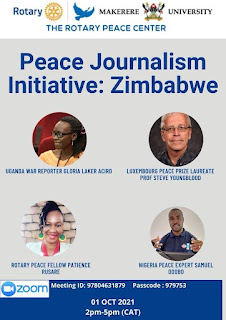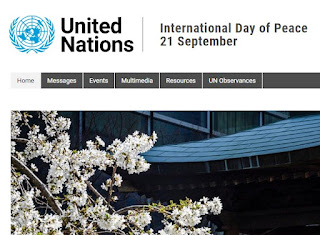Part II: The Infodemic and the PJ Solution
The entry below is excerpted from a chapter I wrote on the infodemic and peace journalism for an upcoming textbook, "The Pandemic and At-risk Society: Perspectives of Communication." Part I of this excerpt is in the previous blog below, and details the infodemic itself. In Part II, I discuss how peace journalism techniques might mitigate the infodemic--Ed.
When it comes to reporting about the pandemic, journalism has a mixed report card. Responsible, diligent media have distributed vital, life-saving information, while compassionately spotlighting heroes in the medical profession alongside brave Covid-19 survivors. However, on the darker side, many media, especially partisan and social media outlets, have followed the lead of self-serving politicians bent on spreading misinformation and propaganda regardless of the cost.

The consequences of the “Infodemic” have been dire. In 2020, hundreds of thousands (millions?) believed the virus was a hoax or perhaps that the threat was greatly exaggerated. In 2021, those intoxicated by misinformation are vaccine hesitant, and continue to support policies and politicians that undermine public health initiatives. In terms of lives lost, an August 2020 study in the American Journal of Tropical Medicine said that at least 800 people died and 5,800 people were hospitalized worldwide due to misinformation. Many of these people died from ingesting false cures (methanol, mega vitamin doses, etc.). This study covered just the first six months of the pandemic, from March to August, 2020. Though it’s not strictly scientific to do so, it is still instructive to imagine if this study included another 12 months (from September 2020 to August 2021). If we do this, the 18 month pandemic totals become truly alarming: 2,400 deaths and 17,400 hospitalizations due to misinformation.
The world may never know how many died because, thinking the virus was a hoax or exaggerated, people rejected anti-virus precautions; or how many died or got sick because they incorrectly believed the vaccine was ineffective, dangerous, and unnecessary.
How can journalists improve their coverage so that it mitigates the misinformation? The following list offers some ideas for journalists on how to improve their pandemic reporting using peace journalism principles.
Covid-19 Reporting Using Peace Journalism Principles
1. Always consider the impact of your reporting. Don’t gratuitously make things worse for the people whose stories you report, or for the general public.
2. Accuracy is paramount. Rumors can be dramatic and exaggerated. Dangers can be under- reported or downplayed. Facts can be slippery in mid-crisis. Inaccurately quoting a victim can be traumatic; inaccurately quoting an expert can be deadly. Check, double check, triple check facts with experts (virologists, epidemiologists). Remember, politicians are not experts. Also, don’t assume all medical doctors are experts on viruses of this sort, or on public health responses. Check the credentials of all “experts.”
3. Journalists should thoughtfully select the images they use, understanding that they can misrepresent an event, exacerbate an already dire situation, and re-victimize those who have been traumatized. For example, was it necessary to use images of the burning funeral pyres in India in the spring of 2021? Were these images necessary to the viewer’s understanding of the story, or were the images merely used sensationally, to sell newspapers or generate clicks?
4. Don’t prematurely jump on the “blame” bandwagon, or to conclusions, and consider the impact of “blame” reporting on traumatized victims and the public. Post pandemic, journalists should lead societal discussions about future preventative and mitigation measures (without advocating for any one solution).
5. Don’t intrude on victims and their families. The National Union of Journalists (UK) code of conduct says, a journalist “does nothing to intrude into anybody’s private life, grief or distress unless justified by overriding consideration of the public interest. Be honest and clear about what you are doing. Identify yourself.”
6. Avoid inflammatory, sensational language that exacerbates the pandemic’s trauma. Never embellish stories.
7. Research the treatments, cures, and vaccines, so you know the background and can be sensitive to contested narratives (e.g., vaccines are dangerous, hydroxychloroquine is a viable cure, lockdowns aren’t necessary).
8. When reporting about the pandemic, journalists should give a voice to the vulnerable, marginalized voiceless in their societies—minorities, the poor, homeless, prisoners, immigrants, etc. As we know, these groups have been disproportionately impacted by the virus, both in terms of contracting it, and related to the pandemic’s economic impact.
9. Journalists should reject formulaic, stereotypical coverage and instead offer counternarratives about the pandemic’s impact, vaccine-hesitant persons, medical workers, devastated businesses, etc.
10. Journalists should explain to their audiences the shifting nature of scientific knowledge about the virus, the vaccine, preventative and therapeutic measures, etc. Best practices, like masking, went from disfavor to mandatory, confusing many citizens. Journalists need to help the public better understand scientific processes. Adjustments are routinely made to public health recommendations as more data are accumulated, for example. These adjustments prove the system is working, instead of indicating an error by scientists.
(Developed with input from Dart Center Journalism Trauma Reporting Handbook, the Northern Ireland National Union of Journalists Code of Conduct, and the principles of peace journalism.)
Given the life-and-death stakes, reporters must embrace peace journalism and the opportunity it offers journalists to professionalize their Covid-19 reporting.

























